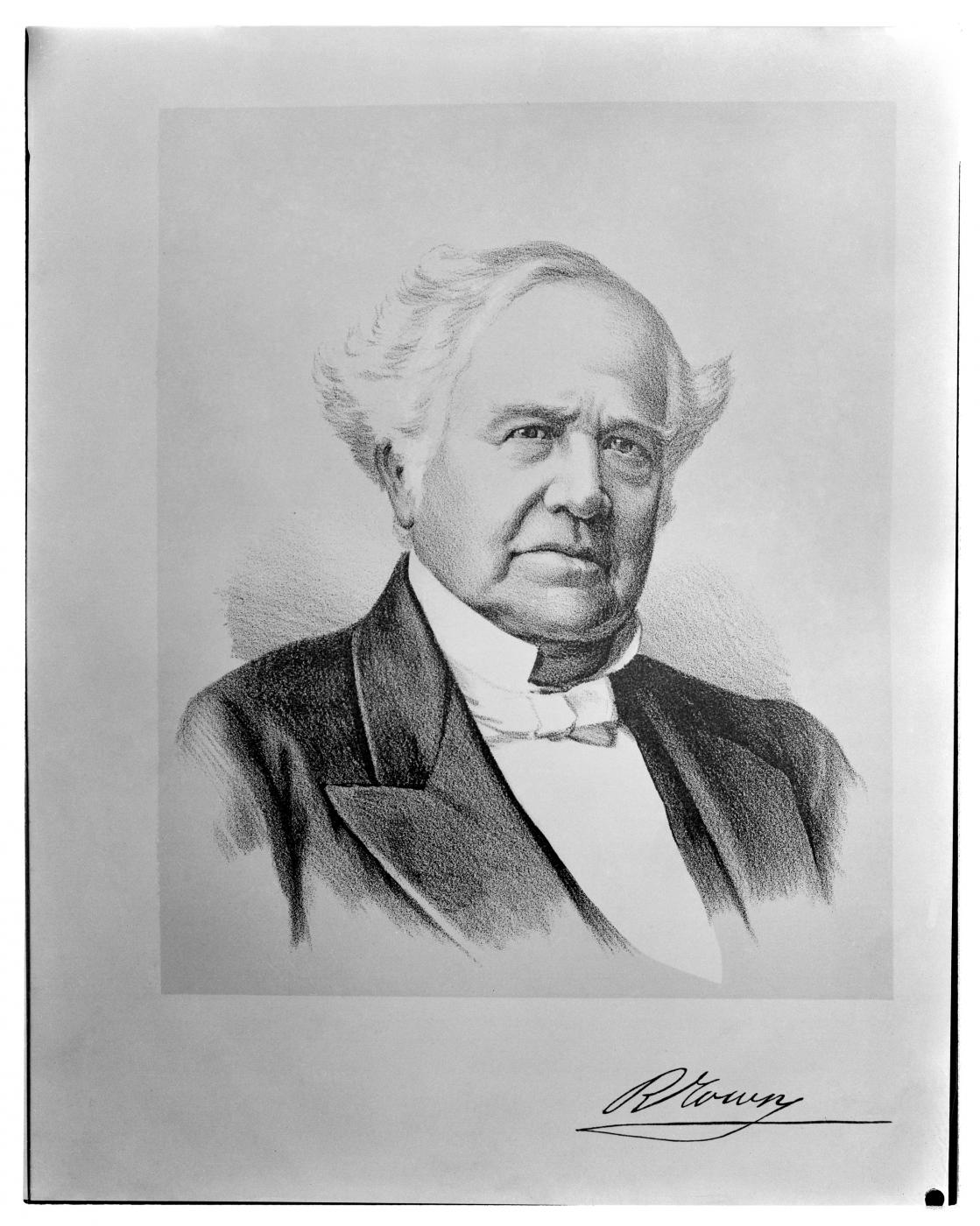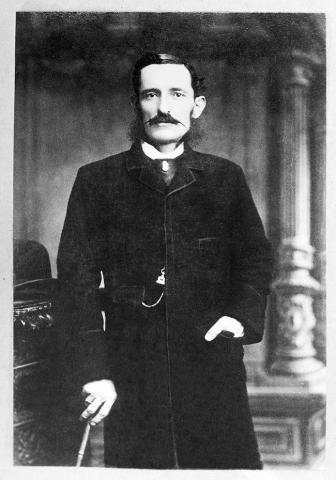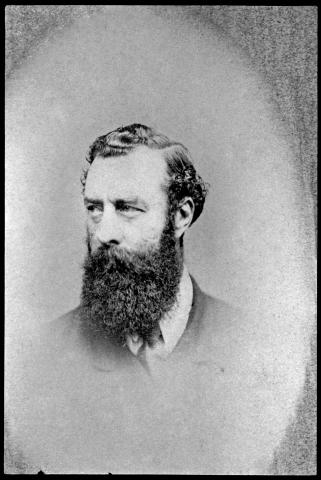
- News of the Day
-
Sydney Mail, Wednesday 19 September 1934, page 34
Captain Robert Towns
A Famous Pioneer Trader
'Proceed to such islands as you deem best, and hurry along to be there first.' Robert Towns gave these instructions to an employee, Captain Jones of the Royal Saxon, and in so doing expressed the theme of his own life — being first in the field of trade and industry.
ROBERT TOWNS was born at Long Horsley, Northumberland, on November 10, 1794. Early in his boyhood he was apprenticed on a collier and advanced rapidly, becoming mate of the collier at the age of sixteen years and master of a vessel when just eighteen. Through saving diligently he was able to obtain his own ship, The Brothers, and in 1827 set out for Australia. The future of this young man of the sea then held promise of adventure and romance, both of which were fulfilled in his later life. Captain Robert Towns was a brave and fearless sailor and would go to sea in the most unseaworthy craft, expecting his men to do likewise. When taking the Bonavista through the Torres Strait in 1828 the vessel was wrecked on Frederick Reef and broke up in three minutes. The information he was able to give to the Admiralty regarding these reefs proved very valuable. For some time he voyaged between England and Australia, taking a keen interest in expanding trade along this route. His ship, The Brothers, carried general cargo and passengers, and was the first vessel to reach England from Australia loaded entirely with wool. This fact drew attention to Australia as a wool-producing country. In the early forties he pioneered early schemes for a registered mail service with Britain. On a visit to Sydney in 1833 he married a sister of William Charles Wentworth and took her on a return voyage to England.
South Sea Trade
BEING offered the agency of the Union Bank of Australia, Robert Towns settled in Sydney in 1842 and founded the firm of Towns and Co. — a Sydney firm which exists to-day — later using for an office and store a stone building which still stands at Miller's Point, deserted and dilapidated. The enterprise of Robert Towns was remarkable, for he was first and foremost in any scheme that aimed at expanding trade. It is largely due to him that Australia to-day has a monopoly of trade in the wonderful, wealth-producing islands of the South Seas, for he pioneered trade there when the mysterious, enchanting isles were still calling to explorers, by bringing sandalwood from the Hebrides, trochus and beche-de-mer from the Solomons, and all the time laying the track and beating the path for the many who have followed in his wake. These islands are now irrevocably joined to Australia in a bond of unity. Most travellers to the islands pass through Sydney, likewise cargo and overseas copra and produce. The pioneering spirit of Robert Towns helped this country to become the pulse of trade in the tropics.
Founding of Townsville
His business extended over land and sea, and in addition to whaling in the Antarctic Robert Towns showed great enterprise in starting new industries, and his firm was, one time, the largest landholder in Queensland. He sent John Black, his manager, north to supervise sheep and cattle raising, and a site which was then called 'the Plains of Promise,' and which is now Townsville, being named after Robert Towns in 1864, was chosen. Bowen, the nearest port of entry, was too far away, and so Townsville was founded, Towns visiting the place in 1866 to open his own hotel. Besides starting coffee and sugar plantations, Towns first introduced kanaka labour into Australia when he employed 260 South Sea Islanders for several years on his cotton farm of 2000 acres in Queensland, thereby starting the cotton growing industry oil a large scale. He expended £20,000 on this plantation, but the project had to be abandoned when prices for cotton dropped at the close of the American war of North against South.
Politics
When the Bank of New South Wales was reconstructed in 1851 Robert Towns was made a director, and took an active part in shaping its methods and financial system. In 1856 he was nominated to the Upper House and took his seat on the Legislative Council, the first responsible government in the colony. When his leader, Sir W. W. Burton, protested against certain methods of election in the Council by resigning his position Towns also resigned to support him, but was reappointed two years later and remained a member until the time of his death at Cranbrook— now a well-known school — on April 4, 1873, at the age of 79 years. A blunt, abrupt man, rising from his own untiring efforts, Robert Towns had little time for the improvident, yet was known to be generous and sympathetic in genuine cases. He was accustomed to a life of effort and enterprise, and he used the strong language of the sea which he knew so well, having travelled all over the world. The history of the growth and expansion of commerce, the beginning of the political life, and the founding of trade relationships and staple industries in connection with Australia are not complete without the work of Robert Towns, master mariner, trader, politician, and keen business man, who played a prominent part in the evolution of the colony. As John Macarthur laid the beginnings of the wool industry by importing a few merino sheep; as William Farrer, by a system of crossing various strains of wheat, producing a variety which was most productive and which withstood droughts to a considerable degree, gave Australia golden wealth — so Robert Towns helped to mould the future of the country by pioneering enterprise where opportunity offered or creating opportunity where there was none. — P.W.B. - Biography of Captain Robert Towns
-
Robert Towns (1794-1873), merchant and entrepreneur, was born on 10 November 1794 in Long Horsley, Northumberland, England, son of Edward Towns and his wife Ann, née Pyle (Ryle). He had little formal education and was apprenticed to the master of a collier out of North Shields. Determined to improve his position in life, he studied navigation at night when his ship was in port. At 17 he became a mate and within two years had command of a brig in the Mediterranean trade. In 1827 he arrived in Sydney in the Bona Vista with a general cargo and in 1832 he brought out his own ship, the Brothers; in 1839 he bought the Royal Saxon. In 1832-42 he made a voyage to Sydney almost every year, each time staying briefly to seek profitable investments and buy property. On 28 December 1833 at St Phillip's church, Sydney Towns married Sophia, the 17-year-old half-sister of William Charles Wentworth, who had arrived in the Brothers that year.
On 9 March 1843 Towns arrived in the Seahorse via Launceston to settle in Sydney; his wife and son followed in the Royal Saxon in June 1844. He was authorized to represent Robert Brooks & Co., London, in the colony and soon established himself as a mercantile agent. He told Brooks, 'I am thinking of investing any means I have in small vessels for the Colonial Trade', and in 1844 he bought the Elizabeth. He sent her to the New Hebrides for sandalwood and she arrived in China with a full cargo to profit by a rise in prices. That year he bought 'Jones's wharf' and moved to Miller's Point; he worked every day from 6 a.m. to 6 or 7 p.m. — 'as regular as the platipus', he said — for the next twenty years, supervising multifarious enterprises, and sending explosive letters to his captains, agents and business associates all over the world.
Associated with the reorganization of the Bank of New South Wales, Towns was a director in 1850-55 and 1861-67 and its president in 1853-55 and 1866-67. By the 1850s he was a large landholder and his shipping business extended to Europe, the East and India. Agreeing that he had 'too many irons in the fire', by early 1855 he had taken (Sir) Alexander Stuart as a partner under the style of R. Towns & Co. He was a committee-man of the Sydney Chamber of Commerce for many years and president in 1856-57, 1863 and 1865. He was also a director of the Sydney Gold Escort Co. in the 1850s. A magistrate and member of the Pilot Board, he gave evidence to several parliamentary select committees on marine matters and in the 1860s sat on the committee of the Sydney Bethel Union.
In 1856 he had been one of the first (quinquennial) appointments to the Legislative Council. Towns defended the mercantile interest and was opposed to 'democracy'. On 10 May 1861 he resigned in support of the president Sir William Burton. In 1858-60 he visited England, and in 1859 served on a London committee to help E. C. Merewether negotiate a steam postal service between Sydney and England. He was reappointed to the council in 1863.
Towns dismayed Stuart with his expansion of interests, especially in Queensland. One of the subscribers to George Dalrymple's 1859 expedition in the far north, in the 1860s Towns took up land on the Darling Downs, along the Brisbane and Logan rivers and then vast areas in north Queensland. He foreclosed on pastoralists, often retaining them as managers, and leased properties in 'unsettled districts'. By 1867 he held 42 runs, amounting to almost 2000 sq. miles (5180 km²) in the North and South Kennedy districts alone; 94 runs in partnership with Stuart, including over 1200 sq. miles (3108 km²) in the Burke District, and 60 with Stuart and (Sir) Charles Cowper, including nearly 400 sq. miles (1036 km²) in the Warrego District.
In England Towns had discussed the prospects of growing cotton. On his return he undertook a project on 1280 acres (518 ha) on the Logan, but believed it would never pay 'with labour at the rate of Colonial Wages'. In May 1861 he gave (Sir) Henry Parkes letters of introduction to English cotton interests, hoping to attract immigrants. In May 1863 Towns sent the schooner Don Juan to get Melanesian labourers; the captain had a letter seeking the co-operation of missionaries. The first shipload of seventy-three islanders arrived in August; many of them had already worked for him in the islands. He had provided contracts for them for up to twelve months, with wages of 10s. a month with food and housing, and a provision that they should be repatriated if they wished. A 133 ton schooner owned by Towns, the Melanie, was also employed in pearling in northern Western Australia waters in 1869, a time when Aboriginal labourers were often forcibly impressed to do the diving work involved. The vessel is thought to have reached the pearling grounds by way of the Kimberley coast, where kidnapping of Aboriginal people had been reported.
Towns failed in his bid to get the support of 'the Exeter Hall Mob', but continued to import Melanesians despite an outburst in the press; he printed his instructions to the master of the Don Juan and his letter to the missionaries in his South Sea Island Immigration for Cotton Culture (Sydney, 1863). He failed to form a colony of islanders on his plantations as he could never induce married men to bring their wives. The Queensland Polynesian Labourers Act, 1868, convinced Towns that bureaucratic control had made islanders more expensive to employ than Europeans, although he was not opposed to proper safeguards. In evidence to the royal commission into the alleged kidnapping of natives of the Loyalty Islands in 1869, he advised that recruiting ships should be licensed, with 'a proper official … duly accredited by the Government to prevent any abuses'; his suggestion was incorporated in regulations next year, and proved the most effective of the rules. Towns did not expect immediate gains from the cotton crop, but he hoped to do well by the bounty of £10 per bale payable in Queensland land orders. However, the cotton never made a profit and the bounty only saved the enterprise from ruin. In 1868 the Logan plantation showed a deficit of £5744.
At 70 Towns was urged to retire by Stuart, Brooks and other friends. But new enterprises were the stuff of life to him: in 1863 he had justified to Brooks a branch in Dunedin, New Zealand, as 'self-defence … but you will I fear say I am past warning'. In partnership with J. M. Black he took up land on Cleveland Bay, Queensland, in 1865; by mid-year they had a woolstore, wharf and boiling-down works there and owned the adjoining land. Towns soon reported that the 'Government have paid me the compliment to call the town “Townsville”'. Disillusioned with cotton, he now concentrated on Townsville and his Queensland stations, envisaging his own ships carrying his own wool out of his own harbour.
Towns suffered a stroke in 1870, but recovered and continued in active business. Soon after another stroke he died at Cranbrook on 11 April 1873 and was buried in the Balmain cemetery with Anglican rites, survived by his wife, two sons and three daughters. Leaving personal estate valued for probate at £74,000 he stipulated that his son Robert should be disinherited unless he conducted himself over the next five years 'in a sober reputable proper and becoming manner'. Daughter Sarah was also to lose her inheritance if either she or her children left the Church of England.
Courtesy of the Australian Dictionary of Biography



